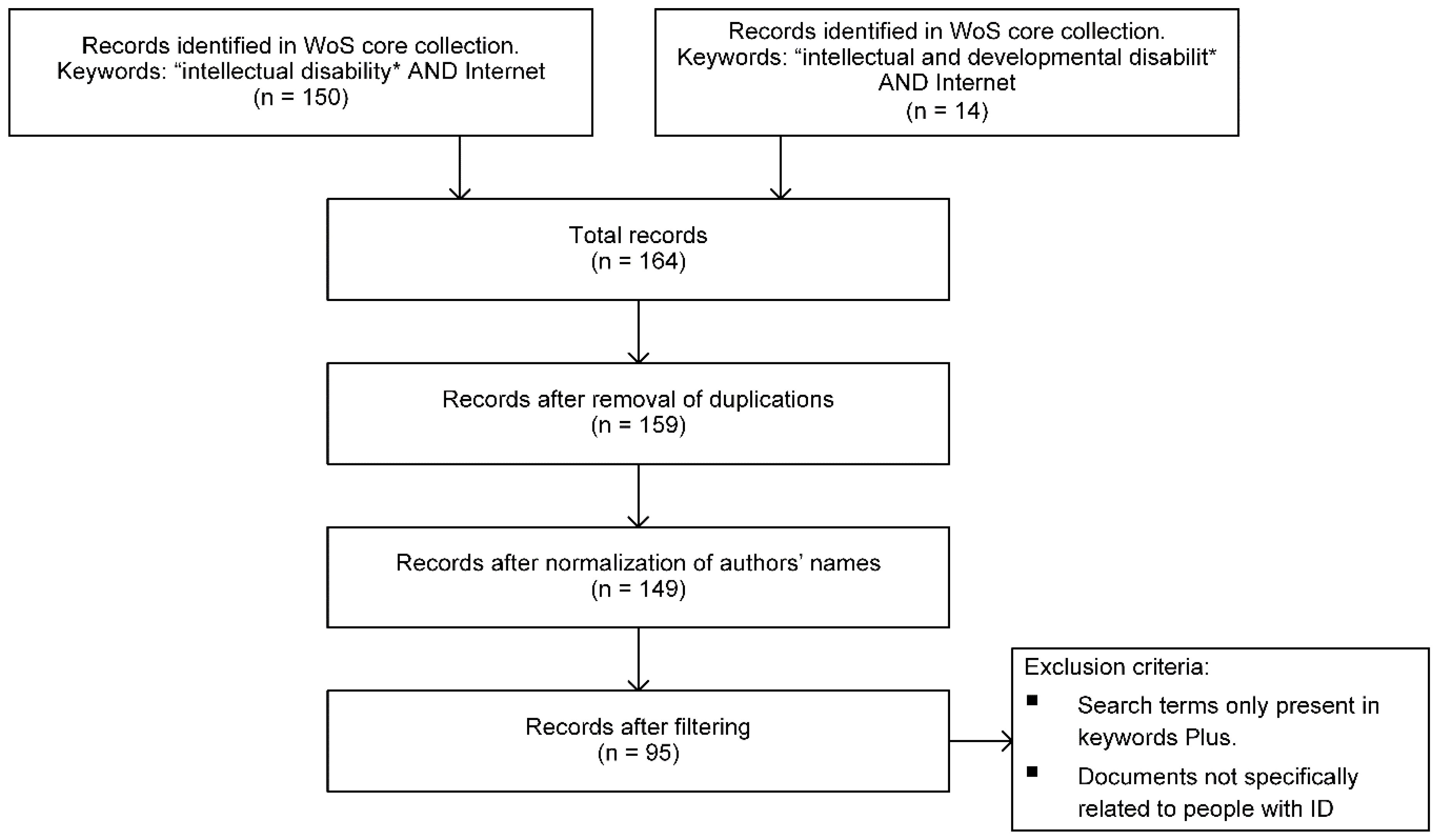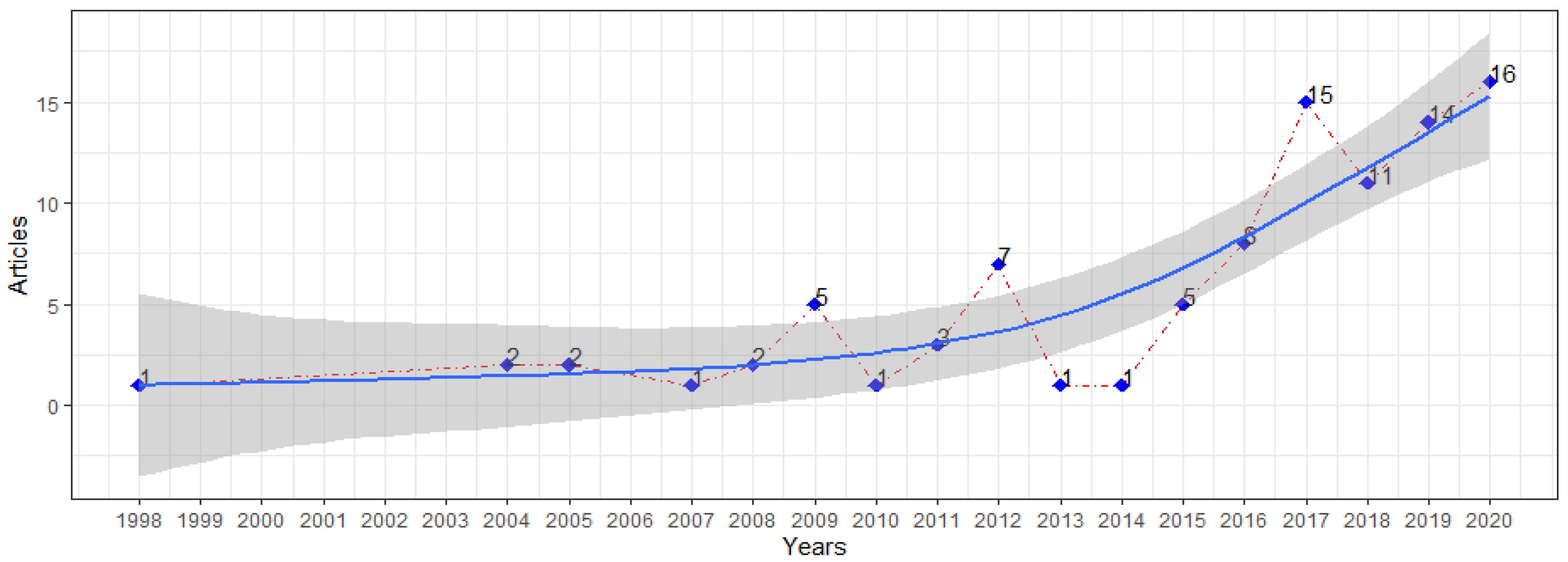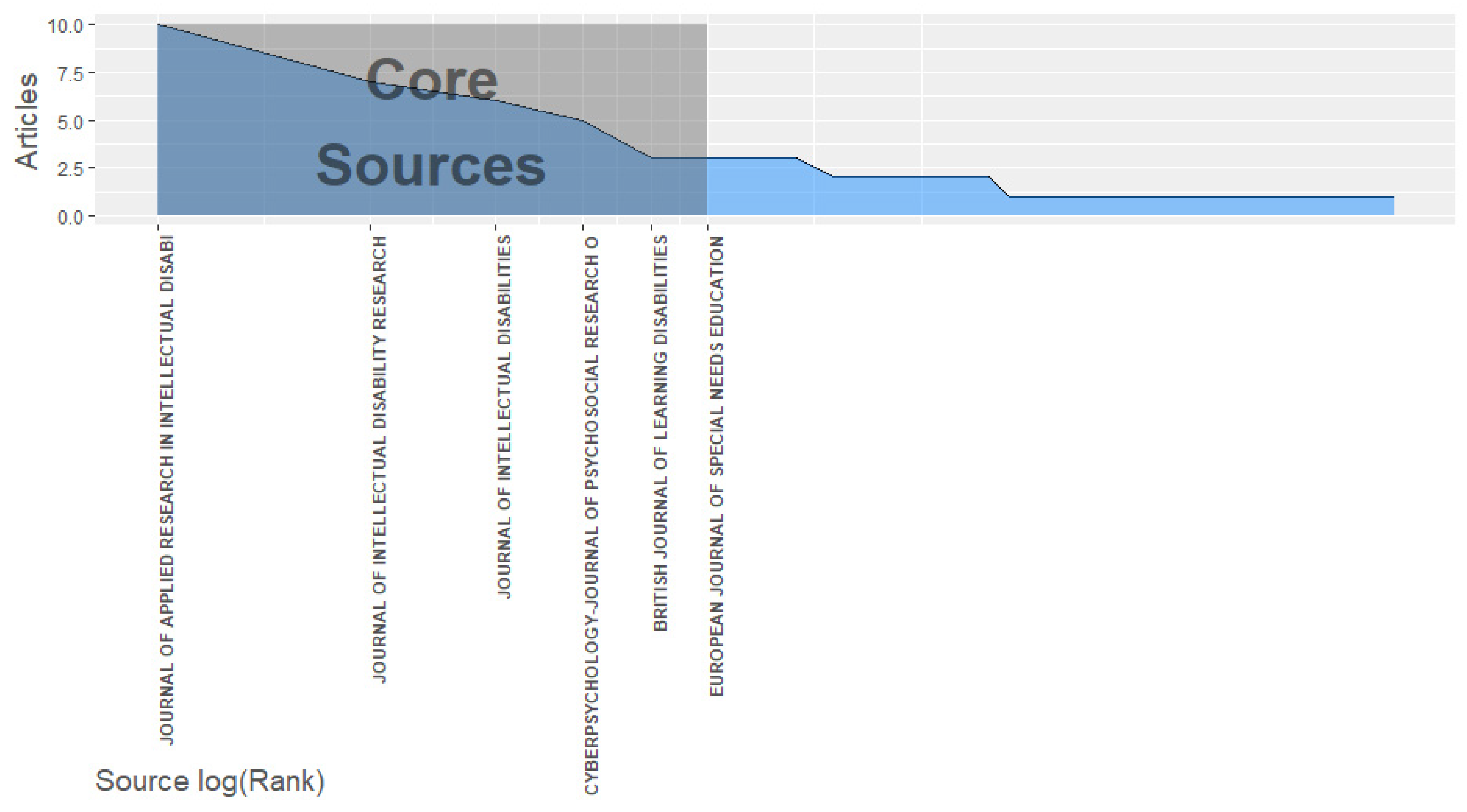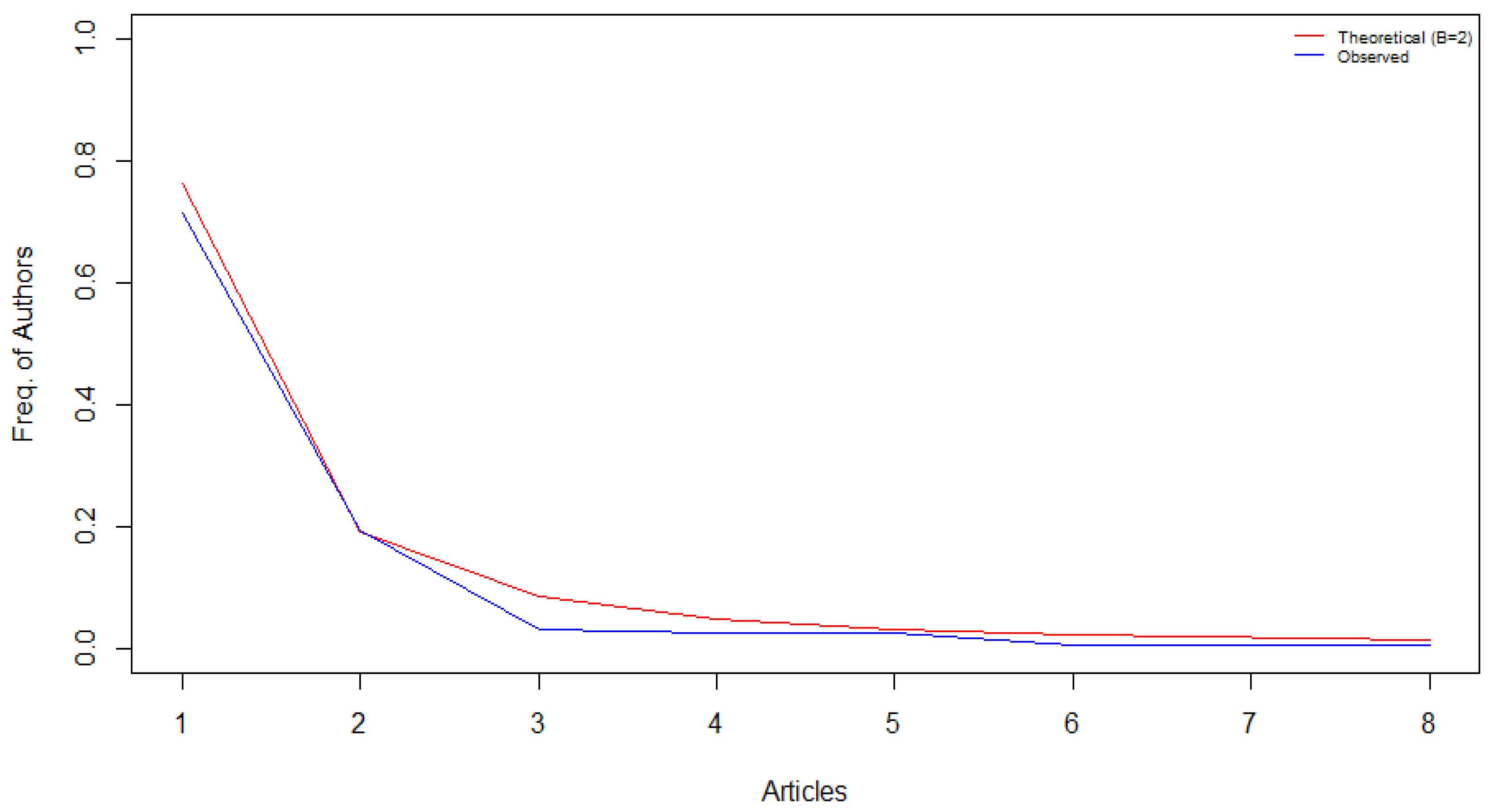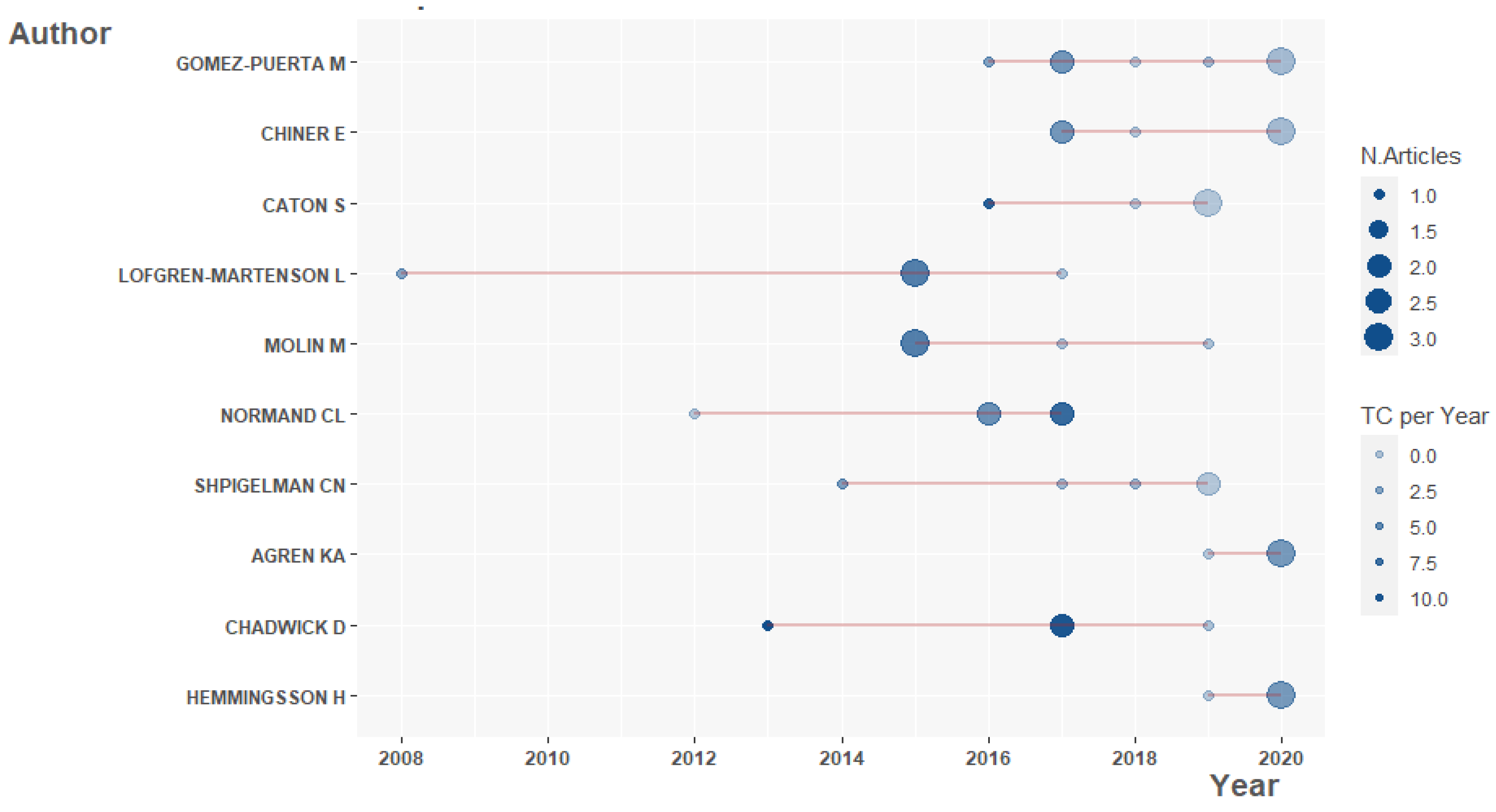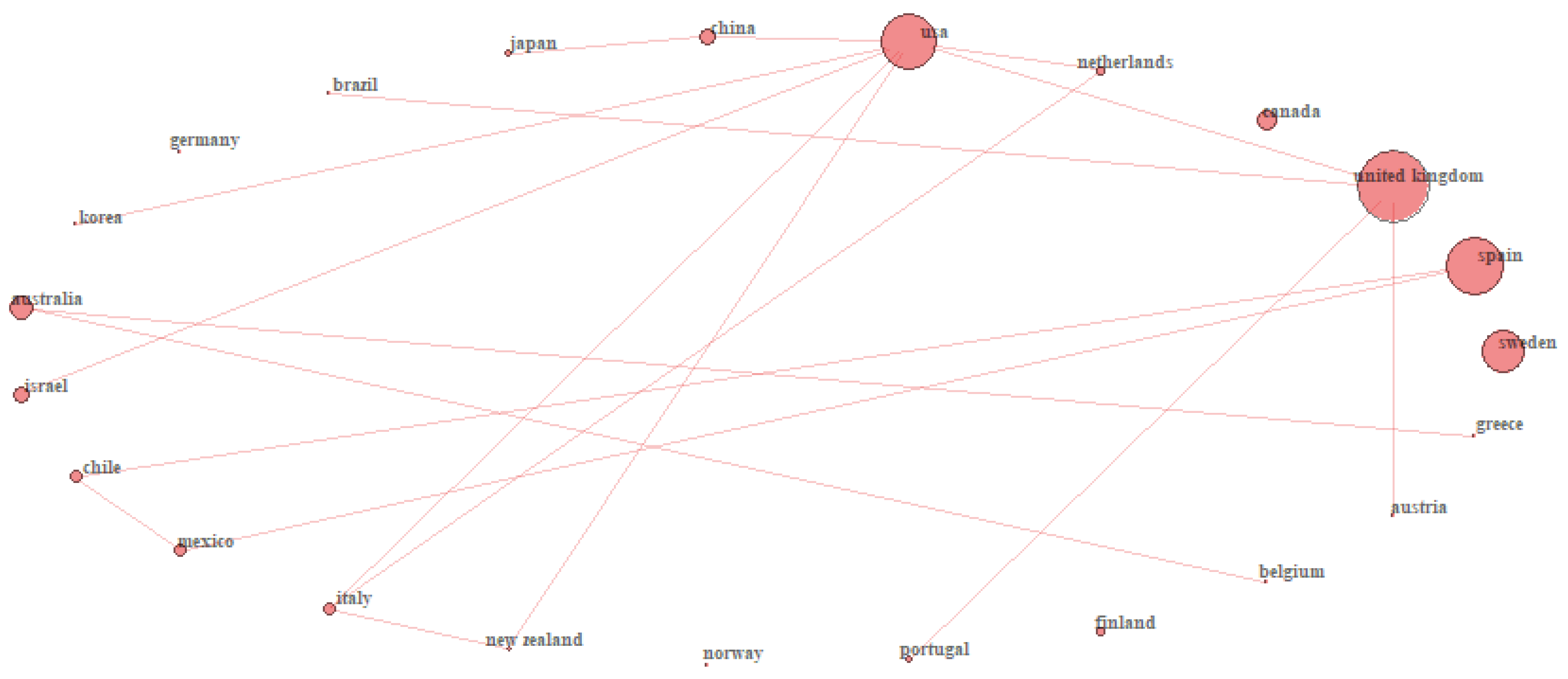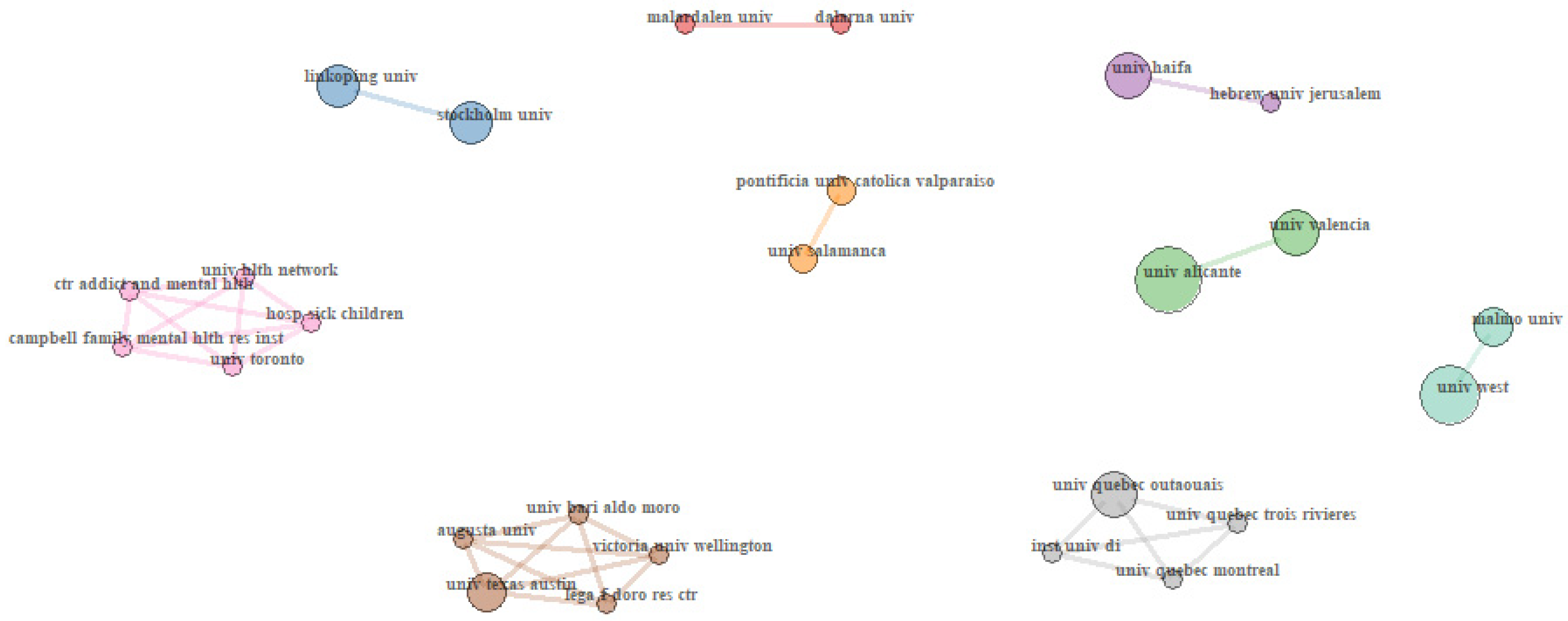1. Introduction
The inclusion of people with disabilities is an area of study that has captured the interest of researchers in recent decades [
1,
2,
3]. This trend has been driven, on the one hand, by international recommendations in defense of their rights [
4,
5] and, on the other, by the development of legislation that would avoid, as far as possible, discrimination against people with disabilities and promote specific positive action measures [
6]. Despite this, there is ample evidence that people with disabilities continue to experience discriminatory situations in their daily lives [
7,
8,
9], that is, experiencing different and unfair treatment with respect to the rest of society. In this regard, the World Health Organization (WHO) has already indicated that discriminatory attitudes towards people with disabilities can negatively affect their possibilities of participation in community life [
10].
The emergence of the so-called information society led to the need for citizens to be able to access and know how to use devices that allow them to consult such information. This event occurred unevenly in different countries, areas and social groups [
11] causing what is known as the digital divide [
12]. The appearance of information and communication technologies (ICT) allowed their use by people with disabilities as learning resources and to promote their personal autonomy [
13]. However, barriers to access and the use of such devices by people with disabilities [
14,
15,
16] soon became apparent, these barriers being of a social, technological, financial or motivational nature [
17]. These obstacles are manifested especially in the case of people with intellectual disabilities, mainly due to the difficulties of the cognitive accessibility of the operating systems and the available information [
18,
19]. In this sense, recommendations have been established to improve the accessibility of ICTs, but also to include training plans for the development of digital literacy for people with disabilities [
4,
5]. On this issue, the 2030 Agenda for sustainable development [
20] has established specific goals for the reduction in inequalities. Specifically, it states that the inclusion of people with disabilities should be promoted (target 10.2) and should guarantee equal opportunities and reduce inequality of results (target 10.3). Additionally, in the educational field, the need to achieve safe, non-violent, inclusive and effective learning environments for all students, including those with disabilities (goal 4.a) is highlighted.
The cheaper price and more widespread use of computers and smartphones favored Internet access for people with intellectual disabilities, although they still do so in a lower proportion than the rest of the population [
17,
19,
21]. Access to the Internet by people with this type of disability has aroused a growing interest in researchers to find out how they use this resource [
22,
23,
24], what benefits they obtain and what risks they are exposed to [
25]. Recently, several articles have analyzed various aspects related to the use of the ICT by people with disabilities using systematic or narrative reviews. First, Sarasola et al. [
26] conducted a bibliometric analysis to examine the impact of the ICT on the teaching and learning process of students with disabilities. Unlike our study, the contribution of Sarasola et al. does not focus on people with intellectual disabilities but includes studies referring to sensory disability, physical disability, autism spectrum disorder, and attention deficit disorders with or without hyperactivity. Furthermore, they do not focus on the Internet specifically, but rather cover various ICT tools and devices in their study. Second, Chadwick [
25] conducted a narrative review specifically in the area of risks associated with Internet use by this group. It describes the studies published in this field and synthesizes the findings regarding the perception of online risk, experiences of risk, online victimization, and possible strategies in managing online risk. Third, Hernández et al. [
27] published a systematic review in which they analyzed the most relevant publications related to the use of information and communication technologies by people with intellectual disabilities. However, there is currently no study that displays an overview of the publications concerning specifically Internet and intellectual disability from a bibliometric perspective, an aspect that this study tries to supplement.
2. Materials and Methods
The main objective of this study was to examine the academic output in the field of Internet and people with intellectual disability. Bibliometric methodology, based on a quantitative approach, was used to analyze and evaluate the performance and the impact of the activity of scientific actors (i.e., authors, countries, institutions) and to build a preliminary science map of the field [
28]. The study was conducted attending to the standard workflow suggested by Zupic and Ĉater [
29], which comprises, along with the research design, the data collection, analysis, visualization, and interpretation.
2.1. Data Collection
This stage of the study consisted of selecting the database and retrieving the data, exporting the records to a bibliometric tool, and filtering the documents.
Firstly, the data was retrieved from the core collection of Web of Science (WoS) on 15 October 2020, since it is considered to be one of the most relevant scientific citation index databases in the academic field [
30]. The key term employed for the search was “intellectual disability” associated with the keyword “Internet”, both included in the Education Resources Information Center (ERIC) thesaurus. However, since the term “intellectual and developmental disability” is frequently used in the literature to refer to individuals with an intellectual disability, it was employed to perform the search as well. In order to guarantee the meaning of the terms, the concepts made up of two or more words were put in quotation marks, and the asterisk was used to address potential word variations (e.g., the singular and plural forms of the term “disability”). Finally, the connector “and” was employed to ensure that the two key concepts were found in either the title, the abstract or the authors’ keywords. In sum, the Boolean logic model used was, on one hand, “intellectual disabilit*” AND Internet, and, on the other, “intellectual and developmental disabilit*” AND Internet, with no restrictions of time, type of source and language (although the search was performed using keywords in English). This stage resulted in 164 documents, 150 for the keyword “intellectual disability” and 14 publications using the keyword “intellectual and developmental disability”.
In a second sub-stage of data collection, the records were exported to the bibliometrix R-Tool (
http://www.bibliometrix.org/), an R-package developed by Aria and Cuccurullo [
31] that provides a comprehensive set of tools to perform quantitative bibliometric and scientometric research.
The next step was data filtering and cleaning that entailed the removal of repeated documents (
n = 5) and the normalization of authors’ names (
n = 10) using the OpenRefine software. Likewise, the records were revised manually to delete those documents that were not directly related to the subject of interest in this study (e.g., publications that did not focus specifically on people with intellectual disability).
Figure 1 displays the workflow of data collection and filtering.
As a result, a final sample of 95 documents related to the Internet and people with intellectual disability was obtained for the period 1998–2020. The majority of the publications were articles (n = 68, 71.58%), including those already published (n = 60) and early access articles (n = 8), followed by 10 meeting abstracts (10.53%), 8 reviews (8.42%), 7 proceedings papers (7.37%), and 2 editorial materials (2.10%).
2.2. Data Analysis and Visualization
The analysis of the data was twofold. Firstly, descriptive analyses were performed for the sources, documents and authors. Secondly, bibliometric techniques were employed to build intellectual, social and collaboration networks, using the author, document, journal, affiliation country, and institution as units of analysis [
32]. Specifically, co-author analysis and citation analyses (i.e., bibliographic coupling and co-citation analysis) were carried out:
(a) Co-author analysis: this technique explores the cooperation patterns between individuals and organizations [
33] and it helps to identify the social structure and collaboration networks at a local, national and international level.
(b) Bibliographic coupling: it is a similarity measure and refers to the frequency with which two works cite a common third work [
33]. It is expected that the more the number of common references there are between two works, the more related is the subject of their study. It is helpful to find related research done in the past (retrospective analysis).
(c) Co-citation analysis: it is another indicator of subject similarity based on the frequency with which two works are cited together by a third [
34]. The relationship between two works will be stronger when they are both cited together by many other documents. This measure is helpful to map the structure of a specific field of research which can change over the time (prospective analysis).
Results were displayed using tables, graphs, and other visualization techniques based on plots and procedures to represent the network mapping, such as sphere layout (e.g., country collaboration network and affiliations), through the creation of bibliometric collections as proposed by Batagelj and Cerinsek [
35] and Aria and Cuccurullo [
31].
3. Results
Findings are presented in the next sections, attending to the following indicators: (a) scientific production, (b) sources production, (c) authors’ production, (d) affiliation production, and (e) collaboration networks.
3.1. Evolution of Scientific Production in the Field
The present study identified 95 documents published between 1998 and 2020, with an 18.92% annual production rate (13.43% excluding early access publications). The highest number of publications are concentrated in the period 2017–2020 (
n = 56, 58.95%), although the scientific production of 2020 could be incomplete since data collection was conducted in October 2020. Despite the fluctuation of publications throughout the years, Price’s model of scientific growth is confirmed in this study. According to Price [
36], scientific production grows exponentially in a way that in a 10–15-year period, it can duplicate. This tendency is confirmed in our study, with a total of 13 documents published before 2010 and 82 publications between 2010 and 2020.
Figure 2 displays the evolution of the scientific production and the growth tendencies curve.
3.2. Sources Productivity
The number of sources that published work about the Internet and intellectual disability was 59, which includes different types of documents (e.g., articles, proceedings, reviews). With regard to the productivity of these sources,
Table 1 shows those that have published three or more works on the topic, with three journals standing out as specifically devoted to the research field of intellectual disability: the
Journal of Applied Research in Intellectual Disabilities (
n = 10, 14.95%), the
Journal of Intellectual Disability Research (
n = 7, 11.86%) and the
Journal of Intellectual Disabilities (
n = 6, 10.16%).
The number of articles per source displayed in
Table 1 confirms Bradford’s law. According to this law, the distribution of scientific production related to a specific subject is highly unequal, with a small number of sources concentrating a large number of publications, while a large group of sources has a similar number of publications [
37,
38].
Figure 3 shows that the core sources with the highest number of publications referring to the Internet and intellectual disability were five, representing 8.9% of the whole sample of sources analyzed. Along with the aforementioned journals,
Cyberpsychology,
British Journal of Learning Disabilities, and
European Journal of Special Needs Education must be considered.
3.3. Authors’ Scientific Production
This section identifies authors’ productivity attending to some indicators such as the co-authorship, the collaboration index, the Lotka’s coefficient estimation, and the authors’ productivity with regard to the subject.
3.3.1. Authors’ Overall Productivity
With regard to the number of authors with publications about Internet and people with intellectual disability,
Table 2 shows the main descriptive variables analyzed. The total production related to the subject has been covered by 196 authors, with an average of documents per author lower than 1% (0.48). Only 12 authors (6.1%) have participated in single-authored documents, while the majority (93.8%,
n = 184) participated in multi-authored works with an average of two authors per document. Finally, the collaboration index (CI) [
39], which is the result of dividing the total number of authors of multi-authored articles by the total number of multi-authored articles, was 2.24. This result indicates that the research teams on this subject are comprised mainly of two researchers.
Likewise, the authors’ scientific production was analyzed using Lotka’s coefficient estimation [
40]. According to this principle, the distribution of authors’ productivity is unequal, with a low number of authors making a greater contribution to the field, while the majority of the authors publish a single article. The findings show an estimated β coefficient of 2.48 with a goodness fit of 0.94. The results of the Kolmogorov-Smirnov test for two samples show a
p-value = 0.93. Therefore, no statistically significant differences were found between Lotka’s theoretical distribution and the observed distribution (
Figure 4), confirming Lotka’s law that states that very few authors have contributed to a greater number of publications, while the majority are single-publication authors.
In this sense,
Table 3 shows how 71% (
n = 140) of the authors have contributed to only one publication, and almost 20% (
n = 38) of the authors have published two documents. The proportion of authors that have participated in more than two works represent less than 9% of all the authors. It should be noted that of the 196 authors that have contributed to the field, only two authors (1%) have produced six or more documents.
3.3.2. Authors’ Productivity
Authors’ productivity was analyzed by determining the number of documents published by the authors on the research field, the authors’ dominance ranking [
41], and co-citation analysis.
Authors’ Publication Productivity
Table 4 describes the productivity in the field of the different authors that comprise the sample in this study. Overall, findings show that only 9.1% (
n = 18) of the authors have written three or more articles on the subject. Gómez-Puerta and Chiner, with eight and six publications, respectively, are the authors with the highest number of documents, followed by Caton, Shpigelman, Löfgren-Martenson, Molin, and Normand with five articles each.
On the other hand,
Figure 5 displays the production over the time of the top-10 most productive authors. In this case, Löfgren-Mårtenson is the researcher that has published more documents about the subject throughout the years. The first article was released in 2008 and the last one in 2017 (with the highest number of publications in 2015). This author is followed by Chadwick (2013–2019), Normand (2012–2017), and Shpigelman (2014–2019). Currently, Ågren, Hemmingsson, Chiner, Gómez-Puerta, Caton, and Shpigelman are the most productive authors in the field (years 2019–2020).
Authors’ Dominant Ranking
The dominance factor (DF) [
40] is a measure that allows the classification of the authors according to their participation as the first author in the publications. The DF has been used in different studies [
39,
42,
43] to identify the dominance of an author in the production of the field of study. It is the result of dividing the proportion of the number of multi-authored publications of an author as the first author by the total number of multi-authored papers of the author.
Table 5 shows the top-10 authors classified according to their DF. The authors with the highest dominance factor (DF = 1.0000) were Caton and Ågren, who were always the first authors in all their multi-authored works. Following are Chiner (five papers as the first author), and Shpigelman and Chadwick with two first-authored articles out of three multi-authored works.
In short, findings show that the top-10 most productive authors are also the most productive authors over the time and with the highest dominance factors.
Most Cited Documents
In addition to the aforementioned analyses, the documents with the greatest impact were examined attending to the number of citations that these works have received. The analyses were twofold. First,
Table 6 displays the most cited works that have the highest average of citations per year (TC per year). That is, the documents with the highest number of citations among all the documents of the WoS core collection database. In this regard, the most cited documents were Didden et al.’s work [
44] and Chadwick et al.’s work [
21] with 140 and 86 total citations, respectively. Both publications are among the six most cited documents of the sample analyzed in this study as well (see
Table 7).
Second, the local citations represent those papers that had a greater impact on the research field. Specifically, it refers to the documents that have the highest number of citations within the set of documents analyzed in this study. In this regard, the most cited documents were Chadwick et al.’s [
21,
45], Löfgren-Mårtenson’s [
46], Molin et al.’s [
47] and Caton et al.’s works [
48]. Findings also show that all of the most local cited documents were also the most global cited works, with the exception of McClimens et al.’s work [
49] that had a greater impact at a local level than at a global level.
Finally, the proportion of local citations (citations within the sample) when compared to the global citations received (citations in the whole WoS core collection data) was estimated. Findings revealed that the three most relevant documents related to the Internet and intellectual disability were Molin et al.’s [
47], Chadwick et al.’s [
45] and Buijs et al.’s [
50] works, with percentages over 79% in all cases. This result means that the three works have been a reference point in the research field (e.g., of the 23 global citations received by Molin’s article, 20 citations are local). On the contrary, while the document with the most global citations (
n = 140) is Didden et al.’s [
44] work, in the specific field of Internet and intellectual disability it has been cited only 15 times (10.71%).
3.4. Country and Affiliation Collaboration
The last set of analyses were oriented to examine the productivity of the countries and institutions as well as to establish collaboration networks among them.
3.4.1. Country Productivity
With regard to the contribution to the subject per country, there are three countries with more than 30 documents each. In particular, Spain has published 35 documents of which 16 are articles, the United Kingdom has published 32 documents, also with 16 articles, and Sweden has 32 documents which 12 are articles. Following are Canada, USA, and Australia with 15 to 25 works. Finally, Israel, China, Finland and Portugal published between four and seven documents (
Table 8).
Concerning corresponding authors’ country, findings show that the collaboration between countries (i.e., multiple country publications) is minimal, with the highest ratio (0.25) for Israel and China. In both cases, they have published one work out of four with authors from different countries.
3.4.2. Institution Productivity
Regarding affiliation,
Table 9 shows the most active institutions concerning their contributions to the field of the Internet and intellectual disability in terms of published works. The University of Alicante, Spain, stands out with 15 documents, followed by the University West, Sweden, with eight documents. Likewise, the Linköping University in Sweden and the University of Valencia in Spain have six publications each.
3.4.3. Institution and Country Collaboration Networks
Finally, collaboration networks among countries and among institutions were examined. As displayed in
Figure 6, USA, United Kingdom, Spain, and Australia are the ones with more research collaborations related to the subject of study. Specifically, the USA has collaborated with European (United Kingdom, Netherlands, and Italy) and Asian (China, Korea, Israel) countries as well as with New Zealand. On the other hand, the United Kingdom has collaborated with Austria, Portugal and Brazil, while Spain has mainly collaborated with Spanish-speaking countries such as Chile and Mexico. Finally, Australian collaboration was with two European countries, Belgium and Greece.
At an institutional level, six collaboration networks stand out with two affiliations per network and three networks that counted on the collaboration of four or five affiliations (
Figure 7). In general, affiliation collaboration networks are among institutions from the same country, either for networks with only two affiliations (e.g., Sweden: Malmö University and University West; Spain: University of Valencia and University of Alicante; Israel: University of Haifa and The Hebrew University of Jerusalem) or for networks with more than two affiliations like in Canada. In this country we find collaborations, on one hand, among francophone affiliations (Université du Québec à Trois-Rivières, Université du Québec en Outaouais, Université du Québec à Montréal, and Institut universitaire en DI et TSA), and, on the other hand, among English-speaking affiliations (University of Toronto, Campbell Family Mental Health Research Institute, University Health Network, Toronto, and Centre for Addiction and Mental Health, Toronto).
Only one institution collaboration network comprises affiliations from different countries. In this case, the international research collaboration was among Italy (University of Bari Aldo Moro), New Zealand (Victoria University of Wellington), and the USA (Augusta University, GA, and University of Texas at Austin, TX).
4. Discussion
The purpose of this study was to examine academic publications related to the field of the Internet and people with intellectual disabilities using a bibliometric methodology. Specifically, scientific production, sources, production by author and affiliation, and collaboration networks were analyzed.
Scientific production, related to the Internet and people with intellectual disabilities, began in 1998 and has progressively increased to the present, adjusting the growth of publications to what is expected according to the Price’s model of scientific growth [
36], that is to say, a growing scientific interest in this field, doubling scientific production in the last 15 years. This fact occurs in parallel with the efforts made to promote digital literacy and Internet access for people with intellectual disabilities [
4,
5,
6,
8].
Regarding sources, the 95 studies analyzed were published in a total of 59 journals, a fact that shows a significant dispersion of production sources. Despite this, three specialized journals on intellectual disabilities (i.e., Journal of Applied Research in Intellectual Disabilities, Journal of Intellectual Disability Research, Journal of Intellectual Disabilities) compile a third of the publications, which are very prestigious and are indexed in the Journal Citation Reports (JCR). Regarding authorship, the data show that the publications are largely the result of a co-authorship. Likewise, scientists tend to work and publish preferably in pairs, as has been shown by the Collaboration Index [
39]. As in the case of publication sources, published studies are the consequence of the work of a small group of authors, thus fulfilling the Coefficient of estimation of Lotka [
40]. Only Löfgren-Mårtenson presents publications for a period close to 10 years, which represents almost half of the period of time in which the analyzed publications are distributed. Her publications are related to participation on the Internet, young people with intellectual disabilities, and love and sexuality on the Internet. In general, the most cited research tends to be the oldest, although there are some recent works such as those by Caton et al. [
48] (46 citations) or Chadwick et al. [
45] (86 citations) that have achieved a significant impact on the scientific community specialized in this area. Caton’s study consists of a systematic review and thematic analysis about the use of online social networks by people with intellectual disabilities. On the other hand, Chadwick’s research has addressed the perception of risks and benefits of the Internet for people with intellectual disabilities, as well as the inequalities that these people face when accessing the Internet. In general, the most relevant publications at the local level are also relevant at the global level, which shows that the impact of relevant studies has a significant scientific dispersion, and they are read and cited by scientists around the world.
Most of the publications on people with intellectual disability and the Internet have been produced in the European Union (46.3%), specifically in Spain, the United Kingdom and Sweden. In this regard, a research group belonging to the University of Alicante (Spain) reflects being especially active in its publications, achieving 15% of the total publications analyzed in just four years. The publications of this group are related to the study of the use, benefits and risks of the Internet perceived by people with intellectual disabilities, family members, professionals in the educational field, and the specialized associative field. This fact shows its high productivity in a stable line of research. Collaboration networks between countries for the development of research are still scarce, tending to be carried out mainly between universities in the same country.
The present study has some limitations that should be considered in this regard. In the first place, publications not produced in English were only considered if the key terms in English employed for the search were included in the metadata. This fact may have left out of this bibliometric analysis studies that may be relevant, for example, in the Spanish, Portuguese or French-speaking environment. Second, it should be considered that the studies corresponding to the year 2020 are still incomplete since the data collection was carried out in mid-October. Third, the terms used in our search can also be considered a limitation of the study, especially in relation to the condition of person with “intellectual disability”. Some articles that would have used other words such as “mental retardation” or “cognitive disability” may have been left out of our study sample. Finally, the results presented are derived from some of the data analyses that could be performed. However, there are other complementary analyses that could be carried out in future bibliometric research on this same topic (e.g., co-word analysis to study the conceptual structure of the research field).
